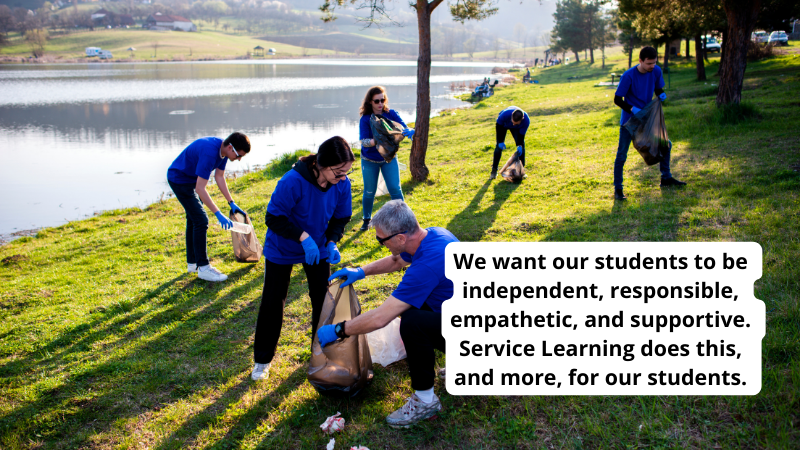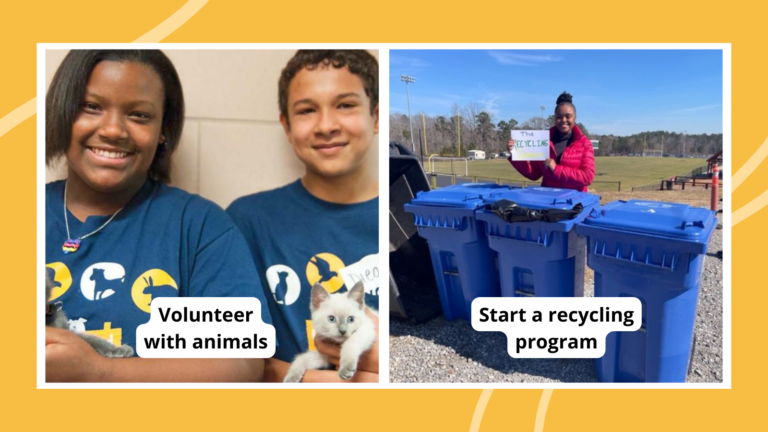We want our students to be independent, responsible, empathetic, and supportive. Planning a project for your students to do to help others is what service learning is all about. One year I invited two homeless teenagers from a local program into my classroom to talk with my second graders about what it’s like to be homeless. Next, I enlisted two students to guide a brainstorm about what homeless teens might need in order to stay clean, avoid boredom, and feel good. Later, we collected many of the items on our list and delivered them to the program. Teaching empathy had been one of my core teaching goals that year, and this project helped me meet that goal with flying colors.
What is service learning, and what makes it important to students’ social and emotional lives?
Service learning, as defined by the National Youth Leadership Council (NYLC), is a teaching and learning approach that fosters civic responsibility and creates meaningful learning opportunities through service to communities. In short, this means kids learn how to be good community members by serving the people, animals, and environment around them because it’s a more natural learning experience. Service learning also improves academic and social outcomes for students because it helps kids feel connected and gives them a sense of belonging. Helping others fills something in us that can’t be met in other ways.
How can I make service learning happen successfully in my classroom?
The most important thing to remember when incorporating service learning in the classroom is to find projects that can be accomplished in a relatively short period of time, are student-driven, and are easily articulated. Projects should be short and student-driven because you want to maintain students’ interest and excitement. Projects should be easy to talk about because you’ll want to share what you’re doing with your administration and with parents. Developing a rationale with a tie to your curriculum may sound complicated or like “more work,” but once you see some examples, I think you’ll agree it’s not that hard and totally worth it.
Here’s how to develop a service learning rationale with a tie to the curriculum.
I’m a firm believer in having a rationale (a pedagogical reason) behind anything I do in the classroom. Not just for myself but for anyone who asks. Service learning is no different, but it doesn’t mean you have to do more. Most service learning lends itself nicely to standards in language arts and social studies, but don’t forget to review your standards in science, math, foreign languages, music, art, and physical education. Identifying standards early ensures that the service learning experience you build provides an authentic outlet in covering your content standards. Students need to know the needs of their community and how they can contribute to solutions in order to make their community stronger. Check out YSA’s Youth Service Knowledge Center for helpful resources to help students figure out how they can understand their community better.
Consider starting with a community-needs-assessment project for some real-world practice.
Want to get your students building awesome skills like responsibility, decision-making, self-awareness, social-awareness, and confidence? You won’t believe how independent your students can be when the outcome is real. Talk with your students about what a community-needs assessment is and why it’s valuable. Consider arranging a date and time for your students to present their findings to your school community for a real-world deadline.
Step 1: Identify the community (30-60 minutes).
Your community may be a block, a neighborhood, or a school. Community is defined as a group of people who share a common bond. The community you will target needs to be identified. Use the following questions to do this:
- How do you describe the boundaries of your community?
- What groups of people live in your community?
- Are there any special needs in your community?
- Where are resources that can be found in your community? (Libraries, grocery stores, gas stations, playgrounds, or anything your students consider important to their community.)
- Who are the leaders and communicators in the community?
Step 2: Consult information sources (60 minutes).
How can you gather this information quickly and accurately? Have your students list anyone who might know the answers to the above five questions. Be sure to have your students gather information on your community assets as well. It’s important to remember that you have a great library, for example, so you don’t get overwhelmed and demoralized as a team. You won’t be able to do everything. Get your students identifying what they need to know and who is going to gather that information. Set up a meeting to share out the information and begin putting it into a Google slide deck or similar application.
Step 3: Survey the community (90 minutes).
This is a super-fun way for kids to identify what their community needs most. Help them create a simple survey (just five questions is usually enough) and identify who they want to take this survey. Talk with them about how a sample of people will bring in just as good results as a large survey of everyone in the community. Then collect the data and talk it over with your students.
Build your service learning project.
Now that you know what you’d like to work on—e.g., more books for the library, planting trees, or helping homeless families with care kits—it’s time to write out your plan and share it with your school community. Here are four types of service learning projects:
Direct Service Learning Projects where students directly serve and impact individuals.
For example, students might teach dance classes to younger kids, volunteer at a homeless shelter, or visit folks at an assisted-living facility.
Indirect Service Learning Projects where students work on issues that are broader in focus.
They might work on researching their town’s history or restoring historic buildings. They could also plant trees and remove invasive plants from areas around their town.
Research-Based Service Learning Projects where students gather and present information on areas of interest.
For example, students could write a guide on community services, research the effects of air quality in their area, or gather information about nonprofit or government agencies within their communities.
Advocacy Service Learning Projects where students can educate others to create awareness.
Students might also encourage action on issues that impact the community. For instance, they might present at public forums, such as City Hall or district board meetings. Students could also create speeches to present to administrators about topics of interest for the school or local needs. Encourage students to work with elected officials in the community to bring changes to city ordinances in order to make their communities better.
Here are some great examples of service learning projects that fall under different curriculum standards:
Art-focused service learning projects
- Teach dance classes to younger kids.
- Draw pictures for seniors in an assisted-living facility.
- Create a replica of your town’s historic district and present it to district or city officials.
- Paint an inspiring mural at the school.
Writing and research-focused service learning projects
- Write a community services guide.
- Create a brochure about your area’s history to explain how your community has changed over time.
- Translate pamphlets or booklets into other languages to help community members who do not speak English.
- Hold a tutoring class after school or at lunch recess to help younger students with reading.
Technology-focused service learning projects
- Create a website to showcase special events happening at school.
- Develop a social media plan to promote a community or school event.
- Write a blog to advocate for change within the community or at your school.
- Create a multimedia presentation that can be used to help younger students master their math facts.
Sports-focused service learning projects
- Organize a walk or run to raise awareness for an issue important to the community.
- Lead and organize a sports tournament for the school to raise money for additional resources that the school needs.
- Create a solution to help make your playground more safe or fun.
- Develop ways to help students with special needs take better advantage of recess games and equipment.
Now help your students spread the word about their service work.
Sharing the service work and its effect on the community is an important lesson to give your students. Service work that’s researched and planned out deserves to be shared. And who knows, it may inspire other classes or community members to take on the challenge of service work themselves.
Consider these ways to share:
- Invite family members to be audience members for a student presentation on community needs and solutions.
- Send a blog post to community members to share the work your students accomplished.
- Go on your school’s social media account to let followers know what’s happening.
Learn more about how you can get started on service learning right now with National Youth Leadership Council.
For even more youth service resources, check out the Youth Service Knowledge Center on YSA.org.


